Mastering Tides at Jones Beach for Kiteboarding
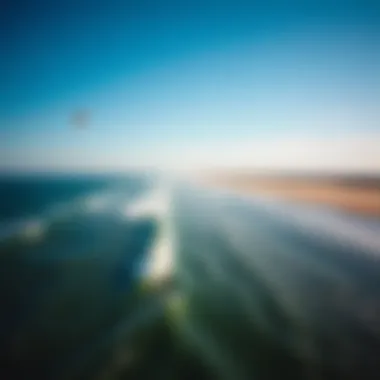
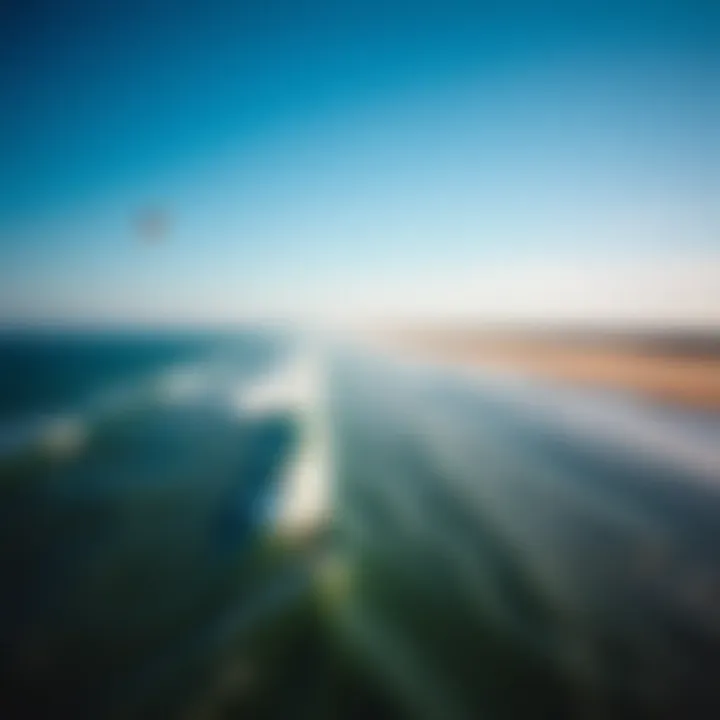
Intro
Kiteboarding at Jones Beach is not just about feeling the rush of wind against your face or the splash of ocean waves—it’s a delicate dance with the tides. Understanding how tides influence your ride is crucial for both safety and fun. In this guide, we’ll explore the ins and outs of tidal patterns, their impact on kiteboarding conditions, and strategies for navigating the waters with ease. Equip yourself with knowledge about timing, safety precautions, and valuable resources to enhance your kiteboarding experience.
Equipment Insights
Latest Gear Reviews
Choosing the right gear isn’t solely about style; it’s about performance and adaptability to changing conditions. Kiteboarders at Jones Beach should prioritize equipment that can handle the unique challenges posed by local tides. High-performance kites, such as the North Kiteboarding Evo or the Duotone Rebel, are popular choices. These models offer versatility, allowing riders to adjust to varying wind conditions that correlate directly with tidal changes.
When evaluating boards, consider the Slingshot Misfit for its stability during choppy waters, particularly when tides are shifting. Each piece of equipment should be rigorously tested in actual conditions, ideally around Jones Beach, to ensure reliability.
"The right gear can make or break your day on the water. Invest wisely."
Essential Gear Maintenance
Adapting to the conditions at Jones Beach necessitates that your equipment remains in top shape. Saltwater and sand can wreak havoc on your gear, leading to greater issues down the line. Here are essential maintenance tips:
- Rinse your gear: After every session, rinse your kite and board with fresh water to remove salt and debris.
- Inspect regularly: Look for any signs of wear and tear, especially on the kite seams and board edges.
- Store properly: Keep your gear in a cool, dry place, away from direct sunlight to avoid material degradation.
A proactive approach to maintenance prolongs equipment life and enhances performance when the tides are in your favor.
Technique Exploration
Beginner Techniques
For those new to kiteboarding at Jones Beach, understanding tide patterns is as important as mastering basic skills. As a beginner, here are some fundamental techniques to turn your tide encounters into triumphs:
- Kite Control: Practice flying your kite on land before hitting the water. A good sense of control will help you navigate shifts in wind and tide, allowing for lighter, safer sessions.
- Wave Riding: Start with smaller waves. Position yourself to catch them while they are still rising, which often correlates with incoming tides.
Advanced Maneuvers
Experienced kiteboarders often ride the rhythm of the tides, leveraging them for advanced tricks and long runs. Here are a few maneuvers that can enhance your performance:
- Jump Timing: Understanding when to jump during a tidal shift can boost airtime. Take advantage of higher tide levels for smoother take-offs.
- Action through Current: Use tidal currents to your advantage. Riding against the tide can build strength, while positioning yourself to ride with the flow can offer exhilarating speeds.
By marrying skill with tidal knowledge, kiteboarders can push their limits while enjoying the majestic water dynamics at Jones Beach.
Finale
Prelude to Jones Beach Tides
Navigating the waters at Jones Beach requires more than just a kite and some wind; understanding the tides is essential for kiteboarders looking to optimize their experience. Tides play a crucial role in shaping the kiteboarding environment, from the water levels that influence how and where one can ride, to the safety considerations that come with shifting currents. Thus, the ability to read and interpret the peculiarities of the tide cycle can significantly elevate a kiteboarder’s proficiency on the water.
Geographical Context of Jones Beach
Situated on the southern shore of Long Island, New York, Jones Beach stretches over six miles along the Atlantic Ocean. Its unique geography, featuring expansive sandy shores and shallow waters, creates an ideal backdrop for numerous water sports, particularly kiteboarding. The presence of bays and inlets nearby also contributes to a diverse tidal landscape, where conditions can vary significantly from one area to another.
The tides at Jones Beach are influenced primarily by lunar phases, local wind patterns, and coastal topography. During a full moon or new moon, spring tides occur, producing higher high tides and lower low tides. Conversely, neap tides, which occur when the moon is in its first or third quarter phases, result in lower tidal ranges. Understanding these geographical and astronomical factors can provide kiteboarders with valuable insights into the tidal dynamics they will face, ensuring they are well-prepared for their outings.
The Importance of Tides for Kiteboarding
The significance of tides in kiteboarding cannot be overstated. They dictate water level changes that can affect everything from the launch and landing spots to the overall ride quality. Here are some pivotal aspects concerning tide importance:
- Water Depth: The best riding conditions often occur at specific water depths, which can drastically change with the tides. Knowing high and low tide timings allows kiteboarders to select the optimal time for riding.
- Current and Flow: Tides create currents that can make riding more challenging or, conversely, more rewarding, based on the timing. A kiteboarder should be aware of how outgoing and incoming tides will affect their ability to maneuver and stay safe.
- Safety Precautions: High tidal changes can introduce hazards, such as submerged obstacles and stronger currents. Recognizing these risks enables kiteboarders to approach their sessions with necessary caution.
"Proper planning around the tides can be the difference between a frustrating session and a phenomenal one."
In essence, grasping the intricacies of Jones Beach tides will not only boost confidence but also enhance the entire kiteboarding experience, making it more enjoyable and successful for enthusiasts of all skill levels.
Tidal Mechanics: How Tides Work
Understanding tidal mechanics is essential for kiteboarders looking to optimize their time on the water. The movement of tides directly influences water levels, currents, and even wind patterns. Getting these details right can mean the difference between a glorious kiteboarding session and being at the mercy of choppy waters.
The dance of the ocean's tides is intimately tied to gravitational forces and the tilt of the Earth. When you grasp how these forces operate, you'll be able to anticipate changes in your environment, which is invaluable for safety and performance.
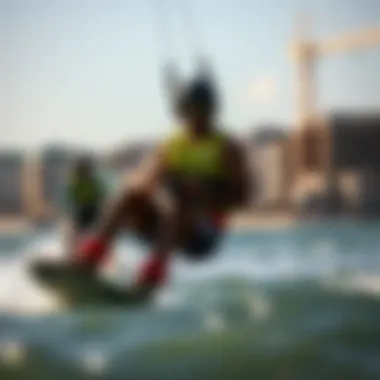
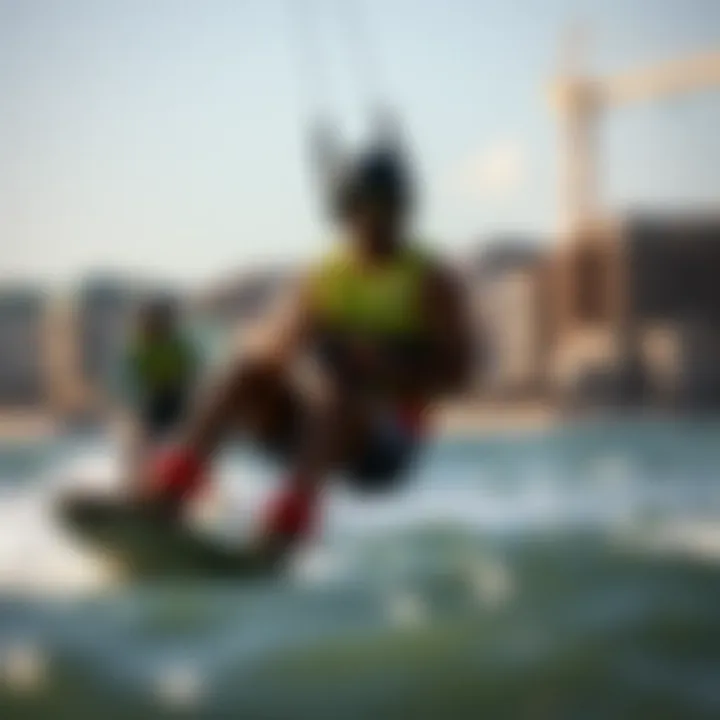
Understanding Gravitational Forces
At the heart of tidal mechanics lie gravitational forces, which stem primarily from the moon and the sun. The moon's gravitational pull creates bulges of water—known as tidal bulges—that result in high tides. As the Earth rotates, different areas pass through these bulges, giving rise to regular tidal cycles. The pull of the sun also plays a role, though it’s less pronounced than that of the moon.
To be precise, the gravitational influence of the moon is about twice that of the sun, but both shapes the tidal regime. When kiteboarders recognize these mechanics, they can better evaluate when to hit the beach for optimal sessions. So, the next time you feel the waves at Jones Beach, remember that there's some interesting gravity at play!
Spring Tides vs. Neap Tides
Now, not all tides are created equal—and that’s where spring and neap tides come into the mix. Spring tides occur twice a month during the full moon and new moon phases. These are when the gravitational forces of the moon and sun align, leading to the most drastic difference between high and low tides. Kiteboarding during spring tides means you may face higher water levels—ideal for challenging conditions but riskier if you’re not prepared.
On the flip side, we have neap tides, which happen at the first and third quarters of the lunar cycle. During neap tides, the gravitational forces cancel each other out to some extent, resulting in smaller tidal ranges. This tidier situation is often better suited for beginners or those who prefer more manageable conditions. Therefore, understanding the difference between these tides helps kiteboarders choose their timing wisely.
A well-timed outing can transform an average day at the beach into an exhilarating experience.
Key Takeaways
- Gravitational forces from the sun and moon drive the tides.
- Spring tides result in extreme tidal movement, while neap tides offer stability.
- Kiteboarders should plan their sessions with the tidal cycle in mind for optimal conditions.
In summary, understanding how tides work isn’t just about science; it’s about enhancing your kiteboarding experience and keeping yourself safe on the waters of Jones Beach.
The Local Tidal Cycle at Jones Beach
Understanding the local tidal cycle at Jones Beach is essential for kiteboarders who wish to optimize their experience on the water. The tides not only influence the water levels but also dictate the conditions that kiteboarders face. In this section, we will address daily and monthly tidal patterns, as well as how seasonal variations come into play. Having a grip on these patterns can fine-tune your kiteboarding sessions, making them safer and more enjoyable.
Daily and Monthly Tidal Patterns
The daily tidal patterns at Jones Beach are primarily governed by the gravitational pull of the moon and the sun. Each day, the beach typically experiences two high tides and two low tides, creating a unique rhythm that can be tracked. It's like a clockwork - you can almost set your watch by it.
When you're planning your kiteboarding outing, pay attention to the timing of these tides. Doing so ensures you hit the water when conditions are optimal. For instance, kiteboarding just before a high tide can provide a marked increase in water depth, which is especially crucial for inexperienced riders or those using larger kites. Additionally, checking monthly patterns can yield insights on how high tides will behave concerning the moon phases. The full moon and new moon can result in higher tidal swings, which often translates to better riding conditions.
"Timing your kiteboarding with the tidal patterns at Jones Beach can turn a good session into a great one."
Seasonal Variations in Tides
Tides are not static; they evolve with the seasons, and what works in summer might not be ideal in winter. At Jones Beach, you’ll notice that as the seasons change, so does the range of the tides. Each season brings its own characteristics due to shifts in weather patterns, temperature, and even prevailing winds.
During the summer months, the tidal range tends to be a bit narrower, providing stable and predictable conditions. An ideal time for kiteboarders, this can mean smooth rides and less dramatic fluctuations. On the other hand, in winter, the tides can become more unpredictable due to storm surges, creating potential hazards. Recognizing these seasonal variations allows kiteboarders to adapt effectively, ensuring they are well-prepared for the type of conditions they might face.
By understanding the local tidal cycle at Jones Beach—encompassing daily patterns and seasonal shifts—you'll better navigate your kiteboarding sessions. This knowledge not only keeps you safe but also enhances the overall thrill and enjoyment of your time on the water.
Impact of Tides on Kiteboarding Conditions
Understanding how tides impact kiteboarding is like having a compass in the wild—crucial for navigation and safety on the water. Tides affect everything from water levels and conditions to the interplay of wind, all of which can significantly influence a kiteboarder’s experience. To truly master kiteboarding at Jones Beach, awareness of these tidal influences serves as a foundation upon which successful sessions are built.
How Tides Influence Water Levels
Tides are not just a matter of rising and falling water; they shape the entire environment kiteboarders operate in. As the tide comes in, water levels rise, providing ample room for maneuvering your kite. This phenomenon creates more space for riders to explore different areas of the beach. Conversely, when the tide goes out, the water can recede quite dramatically, exposing shallow areas that may not be immediately obvious
For kiteboarders, it is crucial to understand how to read tide charts and anticipate the changes in water levels. Here’s a few considerations:
- Launch and Land Zones: Higher water allows for easier access to launch and land your kite without risking exposure to rocks or other hazards.
- Riding Areas: When the tide is at its peak, kiteboarders might find themselves able to ride in areas that are otherwise too shallow or littered with obstacles.
- Board Speed: With more water, the board can glide better, allowing for increased speed and maneuverability, enhancing the overall ride experience.
"The knowledge of tide changes can be the difference between a thrilling ride and a troublesome scrape against the sea bottom."
Effect on Wind Conditions
While water levels dictate how kiteboarders access the beach, tides also play a less evident but equally important role in wind conditions. The wind behaves differently based on the tidal state, which can alter its direction and strength. As the tide shifts, various meteorological factors can change, making understanding these nuances essential for kiteboarders.
Here's how the tides influence wind conditions:
- Wind Patterns: Changing tides can create variations in local wind patterns, sometimes bringing in stronger gusts as the tide rises or lowers. Knowing when these patterns shift can inform when to head out.
- Obstruction Effects: With the alterations in water height, structures like jetties and rocks may obstruct the wind flow differently, which can impact how kiteboarders feel the wind against their sails.
- Optimal Riding Conditions: Some riders prefer to launch during specific tidal states to take advantage of consistent winds that accompany certain tidal conditions, making timing critical to success.
Optimal Times for Kiteboarding at Jones Beach
When it comes to kiteboarding at Jones Beach, timing is everything. Understanding the optimal times enhances the experience on the water and can drastically affect performance. Kiteboarders who take heed of the tidal schedule not only ride smoother but also enjoy safer conditions.
Tides can radically transform the landscape of the beach in just a matter of hours. As the tide comes in, water levels rise, shaping the playing field for kiteboarders. Conversely, during low tide, sections of the beach may become exposed, potentially creating challenges or hazards. This makes knowing the tide schedule essential for maximizing one's kiteboarding session.


Finding the Sweet Spot: Timing Your Session
Identifying the ideal window for kiteboarding at Jones Beach isn't just a matter of luck; it involves careful planning and observation. The sweet spot generally aligns with the incoming tide. During this phase, the water begins to rise, creating optimal conditions for riding. Many seasoned kiteboarders suggest starting about an hour before high tide.
Here's a few benefits of timing your session around high tide:
- Enhanced Water Depth: With deeper water, it's easier to avoid obstacles and debris that may be visible at low tide.
- Improved Wind Conditions: Often the wind patterns shift when the tide is coming in, leading to more favorable riding conditions.
- Better Wave Dynamics: As the tide rises, waves can become more manageable and suitable for jumping.
For those who want to make the most of their outing, tracking tide charts or utilizing tide tracking apps can provide invaluable insights into the best times for hitting the water.
Local Knowledge: Advising from Experienced Riders
Tap into the wealth of experience provided by local kiteboarders. They possess a treasure trove of information that can elevate your kiteboarding game. Many long-time riders at Jones Beach know precisely when shifts in wind and tide create unpredictable conditions, making their tips a gold mine for newcomers.
Some crucial pieces of advice from those in the know:
- Pay Attention to the Forecast: Wind conditions can change quickly. Real-time updates from reliable weather sources will have you riding confidently.
- Connect with Local Communities: Engaging in forums on platforms like reddit.com/r/Kiteboarding or local groups on Facebook could lead to insights that are not published anywhere.
- Visit During Off-Peak Hours: If you're a beginner, aim for less crowded times. Fellow riders can help gauge conditions without overwhelming the water space.
Tip: Whenever possible, align yourself with those who’ve navigated Jones Beach extensively. Their firsthand knowledge can save you from potential pitfalls and lead to safer, more enjoyable sessions.
Safety Considerations Regarding Tides
When you're out there kiteboarding at Jones Beach, one cannot overlook the ever-changing dance of the tides. Safety is not merely a checklist item; it’s the backbone of a successful day on the water. Understanding the local tidal patterns and how they affect kiteboarding conditions is crucial. This section dives into the hazards associated with tidal changes and rip currents, equipping you with knowledge that could well save your day—or even your life.
Awareness of Sudden Tidal Changes
Tides can shift quicker than you might imagine. One moment, you're enjoying a leisurely ride, and the next, the water is rapidly receding or surging towards you. This sudden change can be disorienting and may even catch you off guard. High tides can bring in water that seems to come from nowhere, creating potentially hazardous conditions.
Here are a few things to keep in mind:
- Check the tide table: This should be non-negotiable. Knowing when high and low tides are expected allows you to plan your sessions better.
- Observe the water: If you notice water levels dropping quickly, it’s a sign to either move to shallower ground or return to shore.
- Understand local conditions: Different spots along Jones Beach can experience tidal effects in differing ways. Understanding these localized conditions better ensures that you’re not merely going with the flow but making informed decisions.
"The most dangerous part of kiteboarding is often your refusal to respect the water's power."
Navigating Rip Currents and Other Hazards
Rip currents can be the unseen nemesis for kiteboarders, particularly during transitional tides. Nobody wants to end up in a precarious situation while trying to catch a wave. Here’s how you can deal with these currents:
- Identify risk areas: Certain locations might have a reputation for stronger currents. Familiarize yourself with regions known for rip currents, allowing you to navigate those waters more safely.
- Swim parallel to shore: If you find yourself caught in a rip current, the best approach is to swim parallel to the beach until you’re free of the current’s grip. This strategy is often overlooked but is essential in getting back safely.
- Understand the signs: Turbulent, choppy water, or gaps in breaking waves often indicates the presence of a rip current. Recognizing these signs ahead of time could make all the difference.
Keeping an eye on your surroundings and understanding the tidal patterns will not only enhance your experience but could also be crucial for your safety. When you're well-informed, you can enjoy the thrill of kiteboarding while minimizing risks. This balance is what allows for a sustainable and fun time on the water.
Both the unpredictability of tides and the potential hazards they introduce must be taken seriously. Being prepared means you can focus more on the joy of kiteboarding and less on the perils it might bring.
Tools and Resources for Tide Tracking
Understanding tides isn't just a matter of casually glancing at a water body and making a guess. It’s crucial for kiteboarders to rely on accurate tools and resources to navigate the ever-changing conditions of Jones Beach. With the right information, riders can maximize their kiteboarding sessions, ensuring both invigorating experiences and safety.
Tide Charts and Apps Explained
Among the most accessible resources for tide tracking are tide charts and mobile applications. Tide charts provide detailed predictions on tide heights and times, typically available on a range of formats, from printed sheets to websites that offer live updates. Familiarizing yourself with how to read these charts can make a world of difference. Here’s a simple breakdown of what to look for:
- Times of high and low tides: Knowing the exact time will let you plan your sessions effectively.
- Tide height: This information directly affects the kiteboarding conditions. Too low, and you might find yourself landlocked; too high, and you may deal with more challenging wind conditions.
- Tide phases: Be aware of spring and neap tides, which alter the current significantly. Spring tides will yield a more powerful current and higher differences between low and high tide.
In today’s tech-driven world, apps have become the go-to for many kiteboarders. Applications like "Tide Charts Near Me" or "TideApp" allow users to get real-time data about local tides right in the palm of their hand. This immediacy is particularly valuable when deciding last minute whether to head out or not. The use of apps ensures you are always in the loop, potentially saving you from an unscheduled dousing.
Utilizing Local Weather Stations
Local weather stations play a significant role in understanding tidal dynamics at Jones Beach. These often-overlooked resources can provide real-time data regarding wind conditions, precipitation, and tide levels. Using these tools effectively means combining them with tide charts for a holistic picture of conditions. Being aware of the following aspects can enhance your kiteboarding planning:
- Wind speed and direction: Changes in wind can be substantial and immediate. Wind patterns can shift, affecting the way tides behave and how it feels on the water.
- Weather advisories: Weather stations keep an eye on storms and severe conditions, ensuring you don’t find yourself caught in unfavorable or dangerous weather.
- Historical data: Understanding past patterns can help predict future conditions. Many weather stations provide access to historical tide and wind data, allowing kiteboarders to glean insights about the best times to hit the water.
Understanding Jones Beach Accessibility
Accessibility to Jones Beach plays a crucial role in enhancing the overall kiteboarding experience. Understanding the specifics of how to navigate the beach, particularly the varying conditions presented by tides, can greatly influence the success of a kiteboarding session. Kiteboarders must be well-prepared and informed, as the accessibility can vary not only with the tides but also due to weather conditions and seasonal factors.
Beach Conditions and Equipment Setup
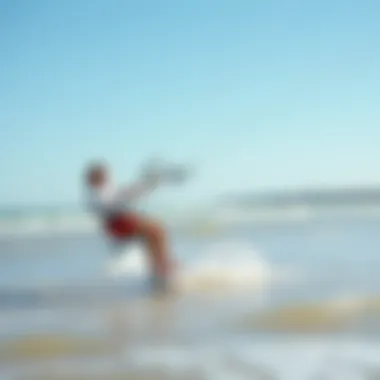
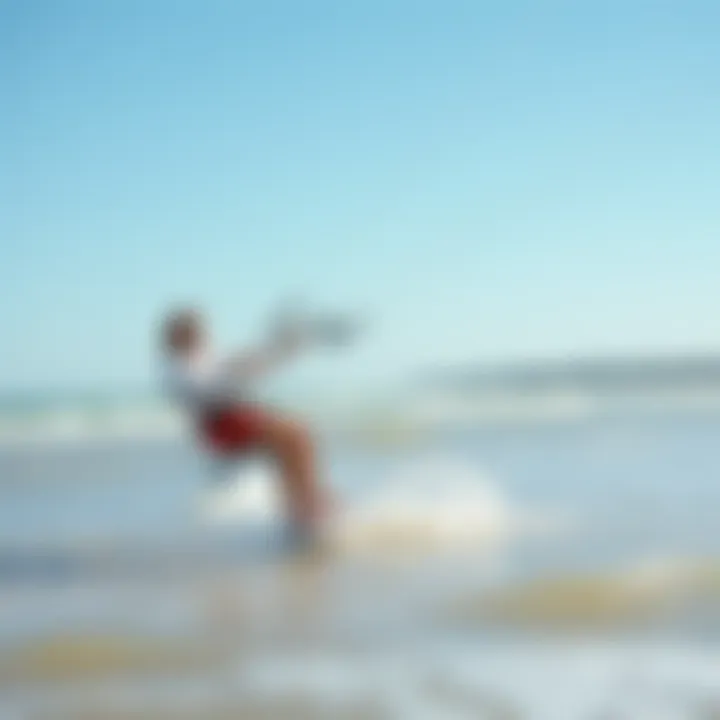
On a typical day at Jones Beach, the overall beach environment changes significantly with tidal patterns. During high tide, certain areas may become inundated with water, making them unsuitable for launching kites. Conversely, low tide unveils expansive sandy areas, offering ample space for setting up equipment and launching. Kiteboarders must keep an eye on the tide schedule and arrive prepared for the conditions they will face.
Equipment Considerations
- Kite Size: Larger kites might work better during gusty conditions often found around high tide, while smaller ones might be favorable when the wind is more consistent at lower tide.
- Bar Length: Depending on water levels, varying the bar length can help manage the kite's responsiveness and control, making it easier to go with the flow rather than fighting against it.
- Safety Gear: Always wear a personal flotation device and consider using a helmet for added safety, particularly in choppier conditions.
Preparation is half the battle; knowing how to set up gear properly can mean the difference between a successful session and getting caught off-guard by rising water.
Access Points During Different Tides
Navigating the beach effectively requires an understanding of where to access the water based on the tides. There are several key points along Jones Beach where entry and exit are optimal during specific tidal conditions.
High Tide Access Points:
- Boardwalk Entrances: During high tide, the boardwalk entrances tend to offer the best access, as they maintain a stable platform despite water encroachment.
- Parking Lot Locations: Some parking lots lead directly to areas where the waves are accessible even when the tide is high.
Low Tide Access Points:
- Wider Beach Areas: When the tide recedes, you'll find extensive stretches of beach that make it easier to unpack and launch kites without being hindered by water.
- Sandbars: Low tide often exposes sandbars, providing natural launch pads and enabling kiteboarders to take off from a solid surface rather than muddy or submerged areas.
"Understanding the accessibility of kiteboarding spots during various tides is as important as knowing your gear. The fluid nature of water can make or break your adventure."
Maintaining awareness of the tide schedules and adapting to the beach's changing conditions not only keeps kiteboarders safe but also maximizes the fun and excitement of their sessions. Routine checks on local tide charts will aid in planning trips and securing an engaging experience suited to any kiteboarding enthusiast.
The Role of Tides in Local Ecosystems
Understanding the tides at Jones Beach extends beyond just the thrill of kiteboarding. These shifting waters play a vital role in local ecosystems, influencing not just the kiteboarders, but also the wildlife and habitats that rely on this natural rhythm. Tides affect nutrient distribution, the life cycles of various species, and the overall health of marshlands and coastal zones. Kiteboarders, in turn, have a unique opportunity to appreciate and engage with these dynamic environments while enjoying their favorite pastime.
Marshlands and Wildlife at Tide Change
As the tides ebb and flow, they bring life and vitality to the marshlands surrounding Jones Beach. When high tides occur, saltwater rushes into these areas, providing essential nutrients that support a diverse array of wildlife, including birds, fish, and various invertebrates. This influx creates a thriving habitat where delicate ecosystems flourish.
The change in tides fosters a cycle; as the water retreats, it exposes the mudflats, allowing various organisms to thrive in the nutrient-rich sediments. Here, you’ll often see shorebirds foraging for crabs, clams, and other small creatures.
When kiteboarders take to the water, they can witness these natural interactions firsthand. Observing the wildlife during kiteboarding sessions can deepen the appreciation for the delicate balance of these ecosystems — a symbiotic relationship that is integral to maintaining the area's biodiversity. It's like a front row seat to a lively, ever-changing performance of nature.
Impact of Tidal Flushing on Marine Life
Tidal flushing, the process of water moving in and out, is crucial for maintaining the health of marine habitats. At Jones Beach, tidal movements help regulate salinity and oxygen levels, both of which are necessary for marine organisms to thrive.
For instance, this flushing action helps to remove stagnant water and pollutants, allowing cleaner, oxygenated water to flow into estuaries and lagoons, facilitating the growth of vital aquatic plants like eelgrass. These plants serve as nurseries for young fish and provide essential food sources for the local marine life.
Moreover, during certain times, especially at spring tides, the increased flushing can stimulate fish spawning and lead to more robust populations. Here are a few organisms that significantly benefit from tidal changes:
- Fish Species: Species like flounder and striped bass are known to thrive during peak tidal movements when food is plentiful.
- Shellfish: Oysters and clams filter feed on plankton and are usually more abundant in areas with healthy tidal flushing.
- Birds: Many migratory species rely on tide changes to find food and nesting areas.
Kiteboarders need to recognize these tides not just for optimal riding conditions, but also for the larger implications on marine life. By fostering a sense of awareness and responsibility, kiteboarders contribute positively to the health of these ecosystems, ensuring that the vibrant life reliant on the tides is preserved for generations to come.
"The tides are a reminder that everything is interconnected; the ocean's dynamics not only shape our riding experience but also nurture the environment around us."
In summation, engaging with the tides at Jones Beach opens the door to understanding the profound connection between water sports and local ecosystems. When kiteboarders are mindful of the environmental impacts, they enhance both their own experience and contribute positively to the delicate balance of this stunning coastal environment.
For further insights into coastal ecosystems, consider these resources:
- Encyclopedia Britannica on Coastal Ecosystems
- Wikipedia on Tidal Marshes
- National Oceanic and Atmospheric Administration - Understanding Tides
Culmination: Elevating Your Kiteboarding Experience
The exploration of tides at Jones Beach is essential for anyone serious about kiteboarding. Understanding how these tides function empowers kiteboarders to make informed decisions on the water. It’s not only about catching the wind; it’s also about riding the rhythm of the ocean. By harmonizing your kiteboarding sessions with the tidal cycles, you can greatly enhance both your performance and enjoyment.
Summarizing Key Insights
As we wrap things up, let’s encapsulate the key insights addressed throughout this guide:
- Tidal Dynamics: Knowledge of spring and neap tides, how gravitational forces come into play, and the local tidal cycles directly shapes your kiteboarding experience. Recognizing peak tide times lets you plan effectively.
- Safety Awareness: Kiteboarding during varying tidal states requires alertness. Being aware of sudden tidal changes and the possible presence of rip currents cannot be overstated. Your safety should always come first, and respect for the ocean is critical.
- Timing Matters: Identifying the best times for sessions based on tides can lead to thrilling rides and favorable conditions. Experienced riders often cite timing as a game changer.
- Ongoing Education: The water is forever changing, with shifting tides influencing conditions. Committing to continual learning through tide tracking and local knowledge ensures that you stay ahead of the game.
"The key to mastering kiteboarding at Jones Beach lies not just in your riding skills, but in knowing the tides as well."
Emphasizing Continual Learning and Adaptation
Kiteboarding is as much about skill as it is about adaptability. The tides change constantly, and just as environments shift, so too must your approach. To stay ahead, immerse yourself in ongoing learning:
- Stay Updated: Utilize tide charts and apps regularly. Knowing how tides change can almost become second nature if you track them over time. Websites like Tide Charts offer comprehensive insights.
- Connect with The Community: Engage with local kiteboarding communities on platforms like Reddit to exchange experiences and gain insights on navigating Jones Beach effectively.
- Experiment and Reflect: Each session offers lessons; take notes on what conditions worked and which didn’t. Tailoring your strategies based on actual experiences allows for keen adaptation to tide changes over time.







